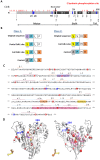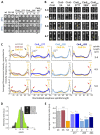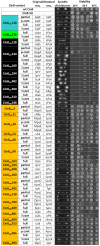Synthetic-Evolution Reveals Narrow Paths to Regulation of the Saccharomyces cerevisiae Mitotic Kinesin-5 Cin8
- PMID: 31223274
- PMCID: PMC6567808
- DOI: 10.7150/ijbs.30543
Synthetic-Evolution Reveals Narrow Paths to Regulation of the Saccharomyces cerevisiae Mitotic Kinesin-5 Cin8
Abstract
Cdk1 has been found to phosphorylate the majority of its substrates in disordered regions, but some substrates maintain precise phosphosite positions over billions of years. Here, we examined the phosphoregulation of the kinesin-5, Cin8, using synthetic Cdk1-sites. We first analyzed the three native Cdk1 sites within the catalytic motor domain. Any single site conferred regulation, but to different extents. Synthetic sites were then systematically generated by single amino-acid substitutions, starting from a phosphodeficient variant of Cin8. Out of 29 synthetic Cdk1 sites, 8 disrupted function; 19 were neutral, similar to the phospho-deficient variant; and only two gave rise to phosphorylation-dependent spindle phenotypes. Of these two, one was immediately adjacent to a native Cdk1 site. Only one novel site position resulted in phospho-regulation. This site was sampled elsewhere in evolution, but the synthetic version was inefficient in S. cerevisiae. This study shows that a single phosphorylation site can modulate complex spindle dynamics, but likely requires further evolution to optimally regulate the precise reaction cycle of a mitotic motor.
Keywords: Cdk1; Cin8; anaphase B; kinesin-5; phosphoregulation.
Conflict of interest statement
Competing Interests: The authors have declared that no competing interest exists.
Figures






Similar articles
-
Three Cdk1 sites in the kinesin-5 Cin8 catalytic domain coordinate motor localization and activity during anaphase.Cell Mol Life Sci. 2017 Sep;74(18):3395-3412. doi: 10.1007/s00018-017-2523-z. Epub 2017 Apr 28. Cell Mol Life Sci. 2017. PMID: 28455557 Free PMC article.
-
Phospho-regulation of kinesin-5 during anaphase spindle elongation.J Cell Sci. 2011 Mar 15;124(Pt 6):873-8. doi: 10.1242/jcs.077396. J Cell Sci. 2011. PMID: 21378308 Free PMC article.
-
Directionality of individual kinesin-5 Cin8 motors is modulated by loop 8, ionic strength and microtubule geometry.EMBO J. 2011 Nov 18;30(24):4942-54. doi: 10.1038/emboj.2011.403. EMBO J. 2011. PMID: 22101328 Free PMC article.
-
Factors that Control Mitotic Spindle Dynamics.Adv Exp Med Biol. 2017;925:89-101. doi: 10.1007/5584_2016_74. Adv Exp Med Biol. 2017. PMID: 27722958 Review.
-
Mitotic motors in Saccharomyces cerevisiae.Biochim Biophys Acta. 2000 Mar 17;1496(1):99-116. doi: 10.1016/s0167-4889(00)00012-4. Biochim Biophys Acta. 2000. PMID: 10722880 Review.
Cited by
-
PTP-3 phosphatase promotes intramolecular folding of SYD-2 to inactivate kinesin-3 UNC-104 in neurons.Mol Biol Cell. 2020 Dec 15;31(26):2932-2947. doi: 10.1091/mbc.E19-10-0591. Epub 2020 Nov 4. Mol Biol Cell. 2020. PMID: 33147118 Free PMC article.
-
Flexible microtubule anchoring modulates the bi-directional motility of the kinesin-5 Cin8.Cell Mol Life Sci. 2021 Aug;78(16):6051-6068. doi: 10.1007/s00018-021-03891-x. Epub 2021 Jul 17. Cell Mol Life Sci. 2021. PMID: 34274977 Free PMC article.
-
Intracellular functions and motile properties of bi-directional kinesin-5 Cin8 are regulated by neck linker docking.Elife. 2021 Aug 13;10:e71036. doi: 10.7554/eLife.71036. Elife. 2021. PMID: 34387192 Free PMC article.
-
Noncanonical interaction with microtubules via the N-terminal nonmotor domain is critical for the functions of a bidirectional kinesin.Sci Adv. 2024 Feb 9;10(6):eadi1367. doi: 10.1126/sciadv.adi1367. Epub 2024 Feb 7. Sci Adv. 2024. PMID: 38324691 Free PMC article.
-
Mechanisms by Which Kinesin-5 Motors Perform Their Multiple Intracellular Functions.Int J Mol Sci. 2021 Jun 15;22(12):6420. doi: 10.3390/ijms22126420. Int J Mol Sci. 2021. PMID: 34203964 Free PMC article. Review.
References
-
- Morgan DO, Roberts JM. Oscillation sensation. Nature. 2002;418:495–6. - PubMed
-
- Choi KY, Satterberg B, Lyons DM, Elion EA. Ste5 tethers multiple protein kinases in the MAP kinase cascade required for mating in S. cerevisiae. Cell. 1994;78:499–512. - PubMed
-
- Mendenhall MD, Jones CA, Reed SI. Dual regulation of the yeast CDC28-p40 protein kinase complex: cell cycle, pheromone, and nutrient limitation effects. Cell. 1987;50:927–35. - PubMed
Publication types
MeSH terms
Substances
LinkOut - more resources
Full Text Sources
Molecular Biology Databases
Miscellaneous

